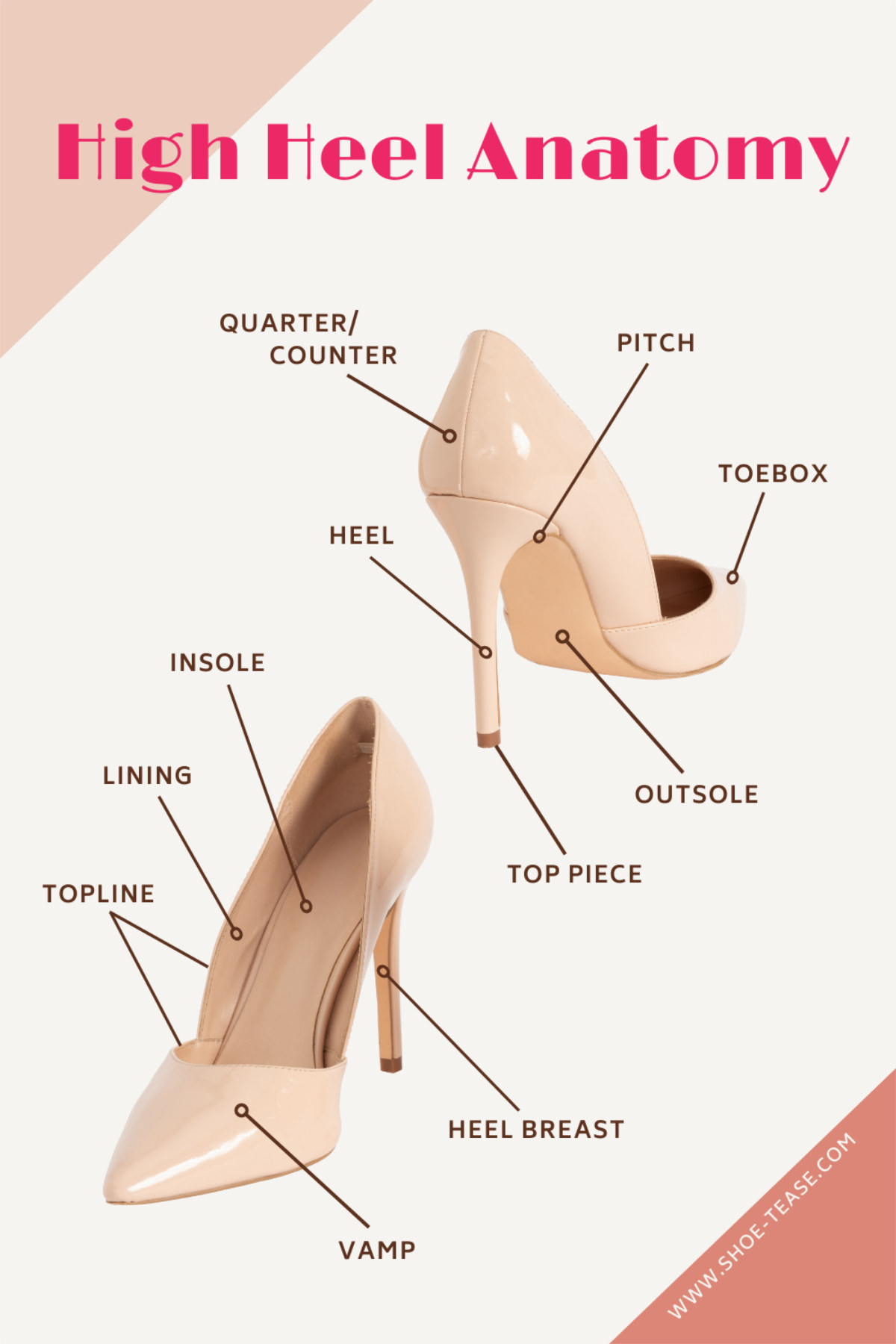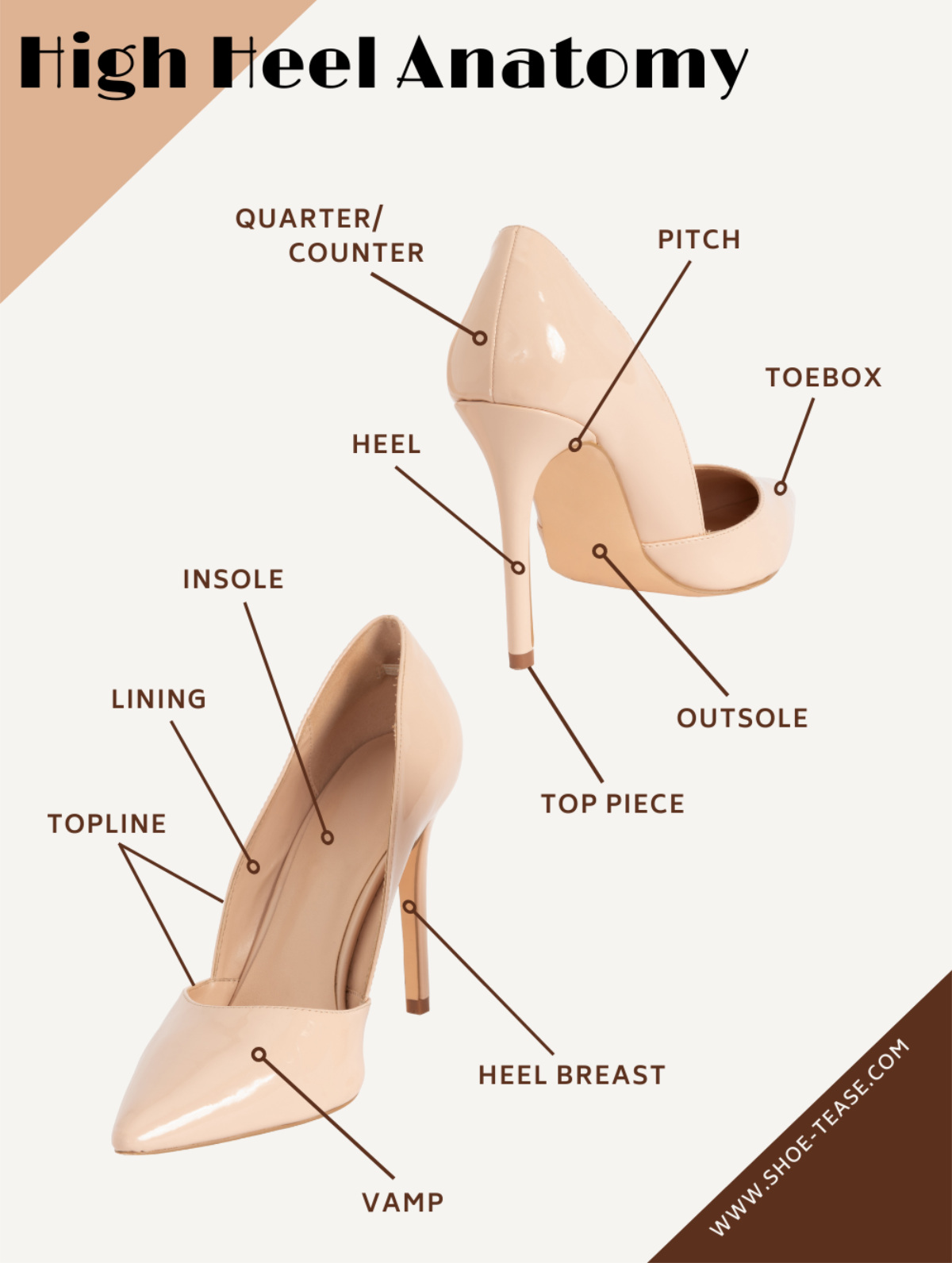Love your high heel shoes, but don’t know much about how they’re constructed? Shoe-tease’s guide on all the different parts of a high heel shoe is here to help with learning the anatomy of a high heel!
Below you’ll find 19 parts of a high heeled shoe that make up most shoes with high heels. Also added is some extra high heel terminology to further your heeled shoe lexicon!
From top to bottom, inside and out I’ll list all relevant high heel parts with names and illustrations to help you in your journey to learn more about heels.
Hopefully, after reading this post, you will never have to ask yourself what the parts of a high heel are called!
Looking for the named parts, for non-heeled shoes? Check out my separate post on all the different parts of a shoe (spoiler- there are a lot!).
Anatomy of a High Heel – 19 Parts of a High Heel

The Upper Parts: from Toe to Heel
Upper
The upper part of a high heel’s anatomy includes all parts located above the sole and heel of the shoe.
Topline
The top-stitched edge of that runs along the heeled shoe’s upper, located at the top of the vamp. It joins the outer materials to the lining while providing shape to the top of the shoe.
Vamp
The vamp is located on the front panel of a high heel shoe that covers the top area of the foot. It spans from the front toe area of the upper until the back quarter, where the heel begins.
The lower the vamp, the more the upper toes – aka toe cleavage – is shown. The higher the vamp, the more the foot is supported. The strap that sits across the foot in a sandal or open-toed shoe is also the vamp.
Toe Box
The toe box is part of the vamp that protects and covers the toes in closed-toe shoes. These can vary in shape, notable in pointed, square, almond-shaped or rounded pumps.
A well-made and designed toe box will reduce the chance of blisters at the toes. Open-toed shoes do not have a toebox.
Quarter
This is the section located right behind the vamp. It extends from the back of the heeled shoe until the vamp begins. The quarter includes all components of the heel itself.
Counter
The counter is a stiff material found at the rear section of the high heel. It provides shape and support behind the foot’s heel. A well-constructed counter will fit snugly around the heel and support the ankles, decreasing the number of blisters at the foot’s heel.
If your heel isn’t well supported, it will slip out, making it difficult to walk in heels. But not to worry! You can learn how to keep heels from slipping out of shoes in my dedicated post.
Lower Part of a High Heel Shoe: Heel & Base
Sole
The bottom part of a high heeled shoe is called the sole. It includes everything below the upper, including the heel portion itself. It is made up of the outsole, insole, heel and any non-visible, interior parts such as the shank.
Outsole
The external part of the sole, where the shoe touches the ground. Often made from leather or faux leather in high heel shoes.
Seat
In a high heel shoe, the seat is the point where the heel attaches to the body of the shoe’s upper. This meeting point is usually seamless, but some high heels are designed so that this is not the case.
Pitch
The height difference between the heel height vs the base of the shoe sole. A platform heel reduces the pitch, making heels more comfortable to walk in.
Heel
Hard to ignore this part when speaking about parts of a high heel! Along with the shape of the shoe itself, the heel defines the shoe’s style. Heels come in a variety of shapes and materials including stacked leather, plexiglass, wood, metal and more.
Heels can be thin like a stiletto or thick and chunky, cone-shaped and more. Heels can range from high or kitten-heel low. To know more, take a peek at my other post all about the different types of high heels.
Heel Breast
The heel breast is the part of the heel that runs vertically from under the foot’s arch. It is often constructed as a continuous piece of material that runs along the sole. This is most notable in high-end high heel shoes.
Top Piece
Ever wondered what that little nub at the base of your heel is called? Technically called the top piece, it is often also called a heel tip, top lift, or as I like to refer to it as: a heel cap.
Usually made of a durable plastic, it gives a stable base to the heel, and helps provide grip when walking.
Many innovative products heel guards have been created to protect and increase traction to your high heels – especially stilettos. Read all about them in my post about high heel protectors.
Platform
Platforms are part of the sole, located on the front of the shoe, under the vamp and toe box. They raise the front of the shoe higher under the ball of the foot.
Platforms can be found on many high heels shoes in a variety of heights and materials.
The Inside Parts of a High Heel
Insole
Often referred to as the inner sole or footbed, the insole is a piece of material shaped similarly to the bottom of the foot. It is located inside the shoe, above all of the following parts: the shank, footbed insole padding and outsole.
It is often cushioned to provide support to the foot’s arch and for general comfort when walking of standing. Most insoles found in high heels are not removable, as they are often in sneakers or dress shoes.
Footbed Padding
Cushioning placed under the insole to support the foot and make high heels more comfortable for the wearer.
Lining
The lining is a material that lines the interior part of the high heel shoes that your foot comes into direct contact with. Made of a softer material such as leather, the lining increases comfort for the wearer and covers any rough seams inside the shoes.
Shank
A shank is found inside the high heel and is not visible after manufacturing. It is a rigid material often made of plastic, metal or wood that is located between the insole and the outsole.
It gives support to the heel counter and the foot’s arch, when walking in the heels.
Stiffener
Stiffeners give shape to the counter, behind the foot’s heel. They are made of a sturdy material attached to the back counter of a high heel shoe, and placed between the upper and lining.
A stiffener provides structure to the counter, preventing it from bending while providing support to the foot’s heel.
Other Notable Parts of a High Heel Shoe
Shoe Last
Not explicitly part of the final high heel shoe itself, the shoe last is a vital component. Considered the foundation of any shoe, it is a 3D form made of either wood or plastic that is somewhat shaped like a foot.
It gives the shape to the upper part of the shoe and is the foundation around which each of the shoe’s uppers is constructed around.
Wedge Heel
Said to be invented by shoe designer Salvatore Ferragamo, a wedge heel is a particular type of high heel. It is a heel designed not to detach from the sole, formed by one continuous piece attached along with the outsole.
It does not have a ‘spike’ like a traditional high heel shoe. It can be made of a variety of materials including wood, plexiglass, cork and other mixed materials.
Ankle Strap
An ankle strap on a high heel is exactly as it is named: an adjustable or strap with hidden elastic, that buckles or ties all the way around the wearer’s ankle.
T-Strap
A t-strap is comprised of 2 parts. The first is a strap attached to either side of the vamp that crosses over the instep, or fastens around the ankle. Another strap is looped onto it and fastens to the vamp.
Tassels
Tassels are decorative in function and can be seen on slip-on shoes such as loafers and high heel loafers. They are located on the instep of a shoe, tassels are usually made of leather or a similar material.
Final Thoughts High Heel Anatomy
And there you have it – all the parts of a high heel so that you’ll not know what the bottom, top or little cap on your heels are called!
I hope I’ve given you a solid grasp on a high heel’s various components and you now know your high heel terminology down pat!
Of course, all heels are different in style and construction. Some will have some parts that others do not, so one high heel’s anatomy will not always be like the next.
This is especially true when looking at hybrid heeled shoes, like stiletto booties, wedge heeled sneakers, or high heeled loafers.
Many heels also have added aesthetic elements such as straps, buckles and other decorative pieces. Men’s footwear-inspired heels and wedding heels are prime examples.
More Post About Women’s Shoes & Heels:
xo ShoeTease
Cristina is the chief editor & shoe expert at ShoeTease. As a seasoned stylist and women's fashion & shoe designer with over 20 years of experience, Cristina's here to guide you on your fashion journey! Learn more.
This post may contain affiliate links. ShoeTease may earn a small commission if you click through and/or make a purchase. Thanks for your support!
